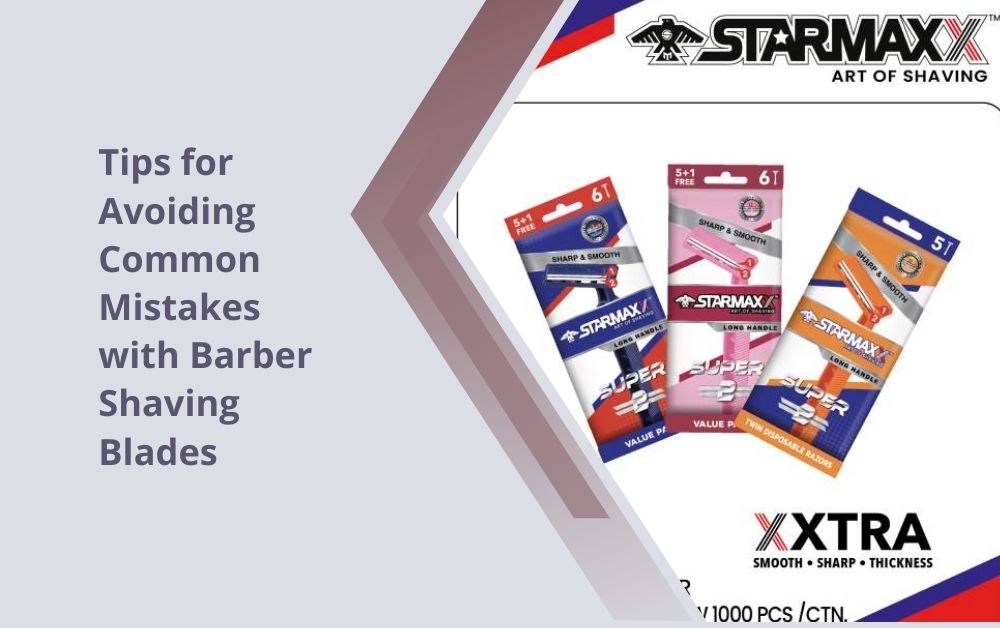Barber shaving blades are essential tools for achieving a clean and precise shave. Whether you’re a professional barber or just someone who enjoys a well-groomed look, knowing how to use these blades correctly is crucial. Misusing shaving blades can lead to poor results and even injuries. In this guide, we’ll explore some common mistakes people make with barber shaving blades and provide simple tips on how to avoid them.

Understanding Barber Shaving Blades
What Are Barber Shaving Blades?
Barber shaving blades are specialized tools used for shaving facial hair. They come in various types, including straight razors, safety razors, and disposable razors. Each type has its own advantages and requires different techniques for proper use.
Why Proper Use Matters
Using barber shaving blades correctly is important for several reasons:
- Safety: Incorrect use can lead to cuts, nicks, and irritation.
- Effectiveness: Proper use ensures a closer and smoother shave.
- Blade Longevity: Using blades correctly can extend their lifespan.
Common Mistakes with Barber Shaving Blades
1. Using Dull Blades
Why Dull Blades Are a Problem
Dull blades are less effective and require more pressure to cut through hair. This can lead to:
- Skin Irritation: Excessive pressure can irritate the skin.
- Uneven Shave: Dull blades can cause an uneven shave, leaving patches of hair.
How to Avoid This Mistake
- Regularly Check Blade Sharpness: Replace blades when they become dull.
- Use a Blade Sharpener: For straight razors, use a sharpening stone or strop to maintain edge sharpness.
NOTE:- Looking to upgrade your shaving routine? Discover our premium range of barber shaving blades designed for a smoother, closer shave. Visit today to find the perfect blade for your grooming needs and experience the difference professional quality can make!
2. Using Incorrect Shaving Technique
Why Technique Matters
Incorrect shaving technique can cause various issues, including:
- Cuts and Nicks: Improper technique can result in accidental cuts.
- Irritation: Shaving against the grain or using too much pressure can irritate the skin.
How to Improve Your Technique
- Shave with the Grain: Shave in the direction of hair growth to minimize irritation.
- Use Gentle Pressure: Let the blade do the work without pressing too hard.
- Practice Proper Angles: Maintain the correct angle to avoid cuts and ensure a close shave.
3. Neglecting Pre-Shave Preparation
Importance of Pre-Shave Preparation
Proper pre-shave preparation helps to:
- Soften Hair: Softened hair is easier to cut and less likely to cause irritation.
- Protect Skin: A good pre-shave routine can protect the skin from damage.
How to Prepare for Shaving
- Cleanse Your Face: Wash your face with warm water and a gentle cleanser.
- Use a Pre-Shave Oil: Apply a pre-shave oil to soften the hair and protect the skin.
- Hydrate: Ensure your skin and hair are well-hydrated before shaving.
4. Skipping Aftercare
Why Aftercare Is Important
Aftercare is essential for:
- Healing the Skin: It helps to soothe and heal any irritation caused by shaving.
- Preventing Infection: Proper aftercare can help prevent infection from cuts or nicks.
How to Care for Your Skin After Shaving
- Rinse with Cool Water: Use cool water to close the pores and reduce irritation.
- Apply Aftershave: Use an alcohol-free aftershave to soothe the skin.
- Moisturize: Apply a gentle moisturizer to keep the skin hydrated.
5. Using Old or Unsuitable Shaving Products
Impact of Old or Unsuitable Products
Old or unsuitable products can lead to:
- Poor Performance: Old shaving creams or gels can be less effective.
- Skin Issues: Using products not suited for your skin type can cause irritation or allergic reactions.
How to Choose the Right Products
- Use Fresh Products: Replace old shaving creams and gels regularly.
- Choose Products for Your Skin Type: Select products designed for your skin type and needs.
6. Not Cleaning the Blade Properly
Why Proper Cleaning Matters
Proper cleaning of the blade is crucial for:
- Preventing Build-Up: Dirt and hair build-up can affect the blade’s performance.
- Ensuring Hygiene: Proper cleaning helps to avoid infections and skin issues.
How to Clean Your Shaving Blade
- Rinse After Each Use: Rinse the blade thoroughly with warm water after each shave.
- Use a Blade Cleaner: For safety razors, use a brush to clean the blade and remove any debris.
- Dry Completely: Ensure the blade is completely dry before storing it to prevent rusting.
7. Using Shaving Blades Beyond Their Intended Use
Risks of Misusing Blades
Using blades for purposes other than shaving can:
- Damage the Blade: Misuse can dull or damage the blade.
- Cause Injuries: Using blades improperly can lead to accidents or injuries.
How to Use Blades Correctly
- Stick to Intended Use: Use shaving blades only for their intended purpose.
- Follow Manufacturer Instructions: Adhere to the guidelines provided by the manufacturer.
Conclusion
Avoiding common mistakes with barber shaving blades can significantly improve your shaving experience and results. By understanding the proper techniques, maintaining your blades, and following a good pre- and post-shave routine, you can enjoy a smoother, more comfortable shave.
For more insightful articles related to this topic, feel free to visit relxnn.com









